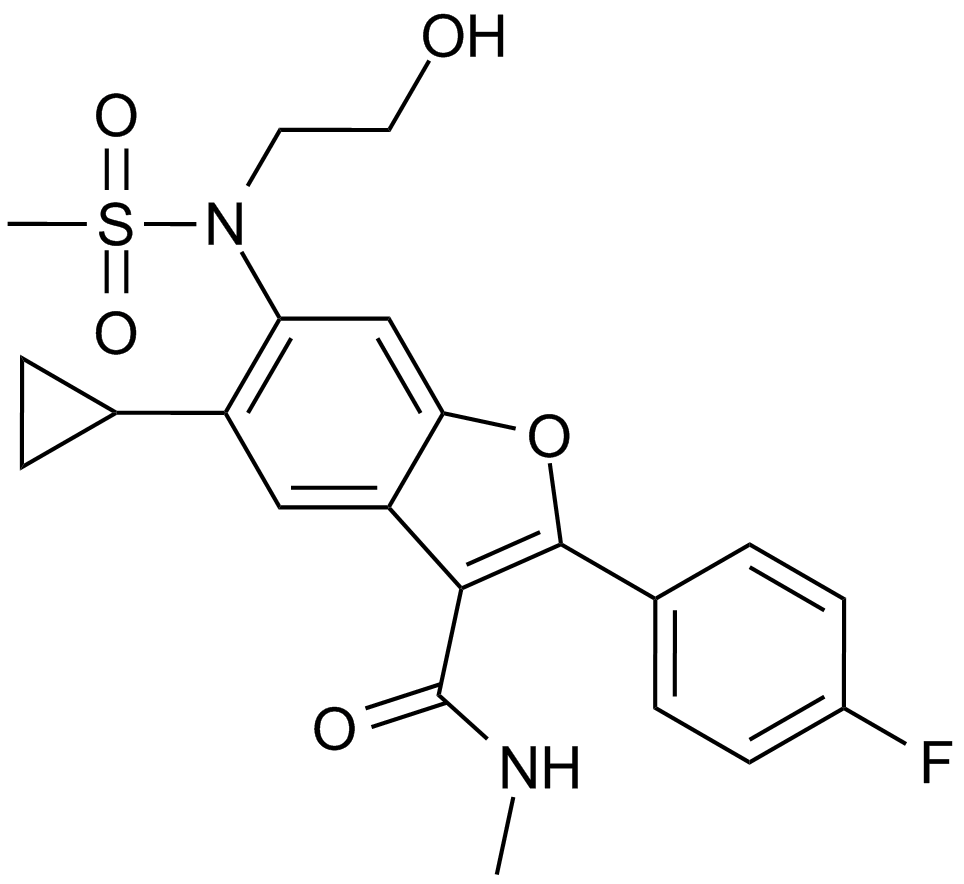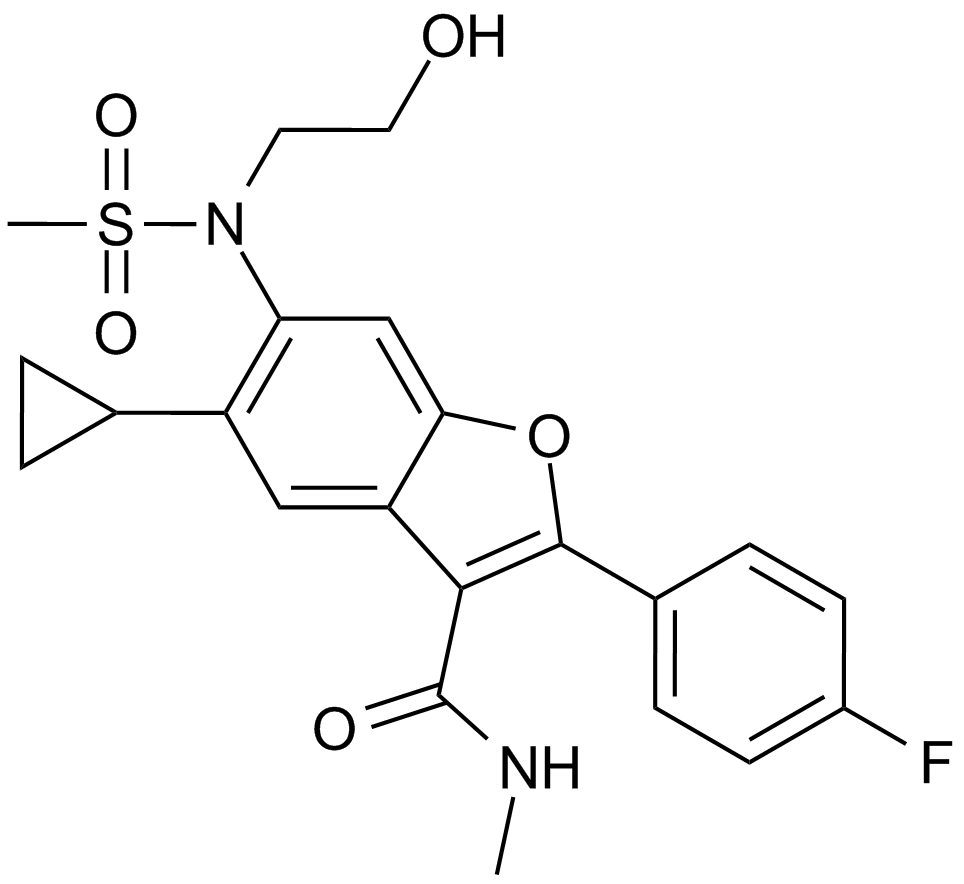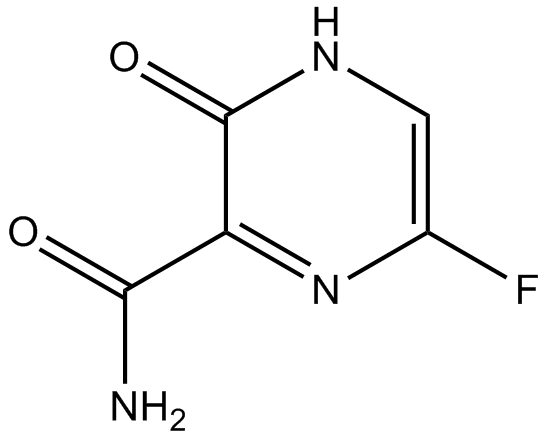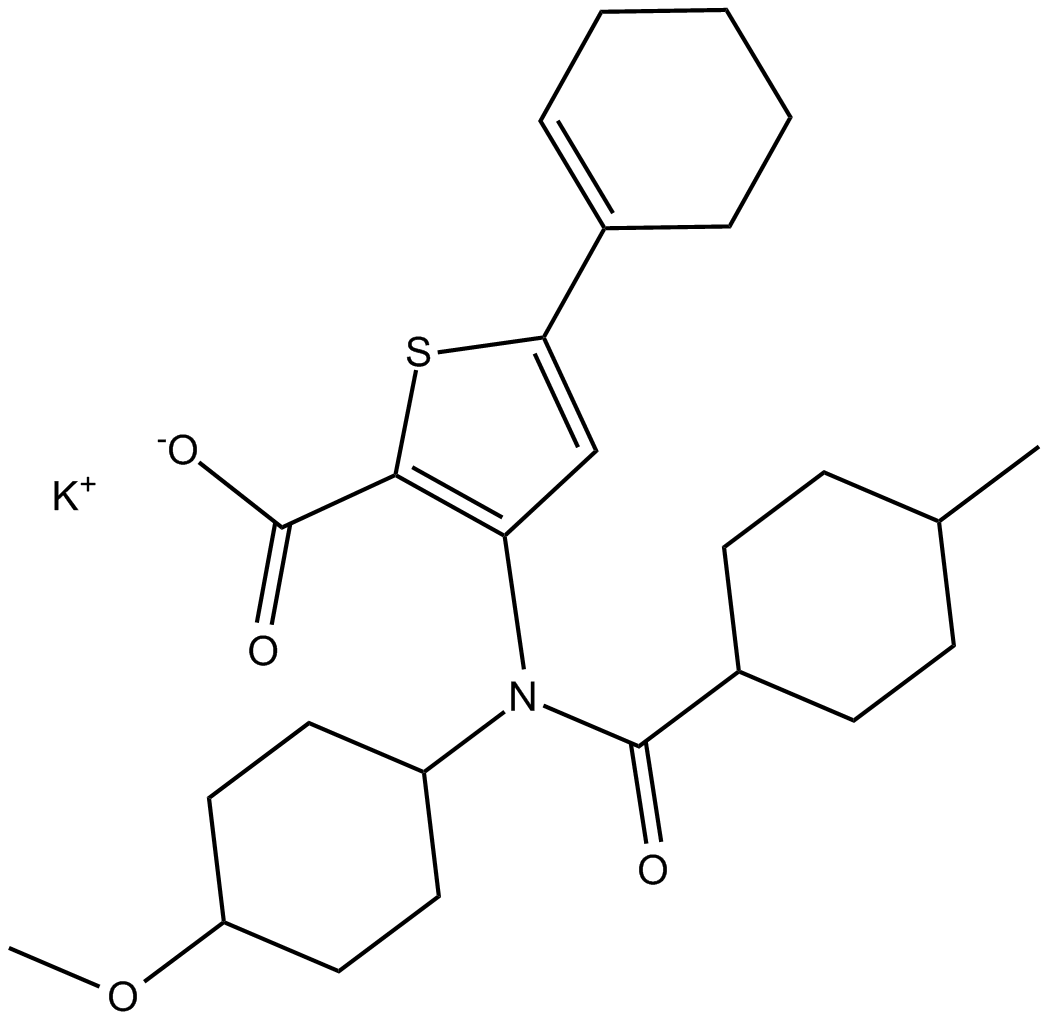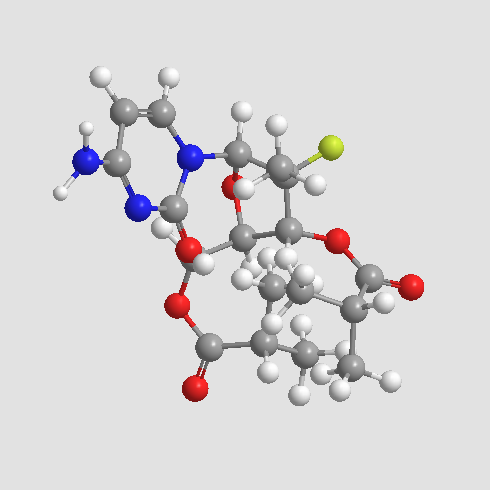Nesbuvir
Nesbuvir is a novel selective inhibitor of nonstructural protein 5B (NS5B) polymerase with IC50 value of 5 nM [1].
NS5B (nonstructural protein 5B) is a viral protein found in HCV and plays an important role in HCV RNA replicate by using the viral positive RNA strand as its template and catalyzing the polymerization of rNTP during RNA replication. As the principal catalytic enzyme for HCV replication, NS5B is a viable target for HCV-RNA replication and used as a target for HCV therapy [2] [3].
Nesbuvir is a selective NS5B polymerase inhibitor and has a different selectivity with the reported ALK inhibitor crizotinib. When tested with Huh7.5 cell line, nesbuvir showed the highest selectivity for NS5B and mutations reduced the cells susceptibility [1]. In Clone A cells derived from Huh-7 cells containing approximately 1,000 genome copies of HCV genotype 1b replicon per cell, nesbuvir treatment with the concentration of 0.1 and 1 μM for 16-day reduced about 3.6 log10 and 4.2 log10 HCV RNA levels, respectively [2].
In the chimeric mouse model, nesbuvir treatment resulted in a 2.02 +/- 0.55 log reduction in HCV titer, whereas in combination with interferon using a suboptimal dose of 30 mg/kg three times per day showed a 2.44 log reduction and were better than interferon treatment only [4].
References:
[1]. Flint, M., et al., Selection and characterization of hepatitis C virus replicons dually resistant to the polymerase and protease inhibitors HCV-796 and boceprevir (SCH 503034). Antimicrob Agents Chemother, 2009. 53(2): p. 401-11.
[2]. Howe, A.Y., et al., Molecular mechanism of hepatitis C virus replicon variants with reduced susceptibility to a benzofuran inhibitor, HCV-796. Antimicrob Agents Chemother, 2008. 52(9): p. 3327-38.
[3]. Meshram, R.J. and R.N. Gacche, Effective epitope identification employing phylogenetic, mutational variability, sequence entropy, and correlated mutation analysis targeting NS5B protein of hepatitis C virus: from bioinformatics to therapeutics. J Mol Recognit, 2015.
[4]. Kneteman, N.M., et al., HCV796: A selective nonstructural protein 5B polymerase inhibitor with potent anti-hepatitis C virus activity in vitro, in mice with chimeric human livers, and in humans infected with hepatitis C virus. Hepatology, 2009. 49(3): p. 745-52.
- 1. Yoshimi Shimizu, Takeru Suzuki, et al. "Antiviral Effects of the Anti-Occludin Monoclonal Antibody on Persistent Hepatitis C Virus Infection in a Human Liver Chimeric Mouse Model." BPB Reports 4,142-147(2021).
| Physical Appearance | A solid |
| Storage | Store at -20°C |
| M.Wt | 446.49 |
| Cas No. | 691852-58-1 |
| Formula | C22H23FN2O5S |
| Synonyms | HCV 796;HCV-796;HCV796,Nesbuvir |
| Solubility | ≥22.3 mg/mL in DMSO; insoluble in H2O; ≥97.8 mg/mL in EtOH with gentle warming |
| Chemical Name | 5-cyclopropyl-2-(4-fluorophenyl)-6-[2-hydroxyethyl(methylsulfonyl)amino]-N-methyl-1-benzofuran-3-carboxamide |
| SDF | Download SDF |
| Canonical SMILES | CNC(c1c(-c(cc2)ccc2F)[o]c2cc(N(CCO)S(C)(=O)=O)c(C3CC3)cc12)=O |
| Shipping Condition | Small Molecules with Blue Ice, Modified Nucleotides with Dry Ice. |
| General tips | We do not recommend long-term storage for the solution, please use it up soon. |
| Cell experiment[1]: | |
|
Cell lines |
Huh7-BB7 cells |
|
Preparation method |
The solubility of this compound in DMSO is > 22.3 mg/mL. General tips for obtaining a higher concentration: Please warm the tube at 37 ℃ for 10 minutes and/or shake it in the ultrasonic bath for a while. Stock solution can be stored below -20℃ for several months. |
|
Reacting condition |
7 d, 40-80 nM |
|
Applications |
Nesbuvir is an inhibitor of the hepatitis C virus (HCV)nonstructural protein 5B (NS5B) polymerase. It has potent and specific inhibitory effect against the HCV RdRp, thus inhibiting RNA synthesis. When Nesbuvir is used in combination with boceprevir, it decreases the frequency with which resistant variants occur in Huh7-BB7 cells bearing a subgenomic genotype 1b HCV replicon. |
| Animal experiment [2]: | |
|
Animal models |
Urokinase plasminogen activator (uPA)/severe combined immunodeficient (SCID) mice |
|
Dosage form |
Oral administration, 50 mg/kg,three times daily for 5 days |
|
Application |
Treating mice with Nesbuvir resulted in a 2.02 ± 0.55 log10 decrease of HCV titer with one mouse below the level of detection, whereas HCV levels in the control group of mice were relatively stable (0.26 ± 0.16 log10 decline). |
|
Other notes |
Please test the solubility of all compounds indoor, and the actual solubility may slightly differ with the theoretical value. This is caused by an experimental system error and it is normal. |
|
References: [1]. Flint M, Mullen S, Deatly A M, et al. Selection and characterization of hepatitis C virus replicons dually resistant to the polymerase and protease inhibitors HCV-796 and boceprevir (SCH 503034)[J]. Antimicrobial agents and chemotherapy, 2009, 53(2): 401-411. [2]. Kneteman N M, Howe A Y M, Gao T, et al. HCV796: a selective nonstructural protein 5B polymerase inhibitor with potent anti‐hepatitis C virus activity in vitro, in mice with chimeric human livers, and in humans infected with hepatitis C virus[J]. Hepatology, 2009, 49(3): 745-752. | |
| Description | Nesbuvir is a selective inhibitor of HCV NS5B RNA-dependent RNA polymerase. | |||||
| Targets | HCV NS5B RNA-dependent RNA polymerase | |||||
| IC50 | ||||||
Quality Control & MSDS
- View current batch:
Chemical structure
